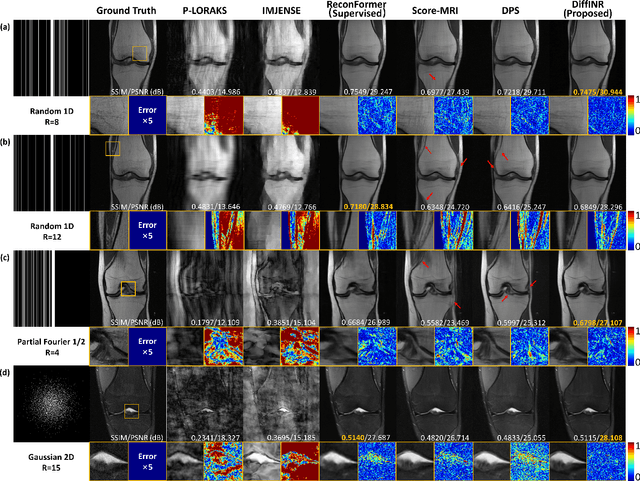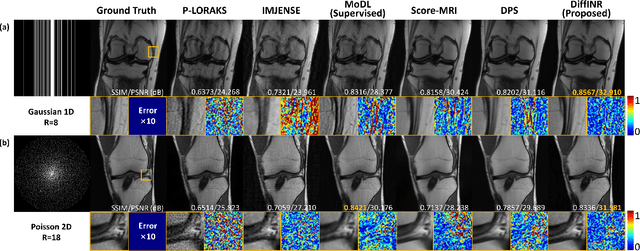Chenhe Du
Unsupervised Self-Prior Embedding Neural Representation for Iterative Sparse-View CT Reconstruction
Feb 08, 2025Abstract:Emerging unsupervised implicit neural representation (INR) methods, such as NeRP, NeAT, and SCOPE, have shown great potential to address sparse-view computed tomography (SVCT) inverse problems. Although these INR-based methods perform well in relatively dense SVCT reconstructions, they struggle to achieve comparable performance to supervised methods in sparser SVCT scenarios. They are prone to being affected by noise, limiting their applicability in real clinical settings. Additionally, current methods have not fully explored the use of image domain priors for solving SVCsT inverse problems. In this work, we demonstrate that imperfect reconstruction results can provide effective image domain priors for INRs to enhance performance. To leverage this, we introduce Self-prior embedding neural representation (Spener), a novel unsupervised method for SVCT reconstruction that integrates iterative reconstruction algorithms. During each iteration, Spener extracts local image prior features from the previous iteration and embeds them to constrain the solution space. Experimental results on multiple CT datasets show that our unsupervised Spener method achieves performance comparable to supervised state-of-the-art (SOTA) methods on in-domain data while outperforming them on out-of-domain datasets. Moreover, Spener significantly improves the performance of INR-based methods in handling SVCT with noisy sinograms. Our code is available at https://github.com/MeijiTian/Spener.
Moner: Motion Correction in Undersampled Radial MRI with Unsupervised Neural Representation
Sep 25, 2024



Abstract:Motion correction (MoCo) in radial MRI is a challenging problem due to the unpredictability of subject's motion. Current state-of-the-art (SOTA) MoCo algorithms often use extensive high-quality MR images to pre-train neural networks, obtaining excellent reconstructions. However, the need for large-scale datasets significantly increases costs and limits model generalization. In this work, we propose Moner, an unsupervised MoCo method that jointly solves artifact-free MR images and accurate motion from undersampled, rigid motion-corrupted k-space data, without requiring training data. Our core idea is to leverage the continuous prior of implicit neural representation (INR) to constrain this ill-posed inverse problem, enabling ideal solutions. Specifically, we incorporate a quasi-static motion model into the INR, granting its ability to correct subject's motion. To stabilize model optimization, we reformulate radial MRI as a back-projection problem using the Fourier-slice theorem. Additionally, we propose a novel coarse-to-fine hash encoding strategy, significantly enhancing MoCo accuracy. Experiments on multiple MRI datasets show our Moner achieves performance comparable to SOTA MoCo techniques on in-domain data, while demonstrating significant improvements on out-of-domain data.
Highly Accelerated MRI via Implicit Neural Representation Guided Posterior Sampling of Diffusion Models
Jul 03, 2024


Abstract:Reconstructing high-fidelity magnetic resonance (MR) images from under-sampled k-space is a commonly used strategy to reduce scan time. The posterior sampling of diffusion models based on the real measurement data holds significant promise of improved reconstruction accuracy. However, traditional posterior sampling methods often lack effective data consistency guidance, leading to inaccurate and unstable reconstructions. Implicit neural representation (INR) has emerged as a powerful paradigm for solving inverse problems by modeling a signal's attributes as a continuous function of spatial coordinates. In this study, we present a novel posterior sampler for diffusion models using INR, named DiffINR. The INR-based component incorporates both the diffusion prior distribution and the MRI physical model to ensure high data fidelity. DiffINR demonstrates superior performance on experimental datasets with remarkable accuracy, even under high acceleration factors (up to R=12 in single-channel reconstruction). Notably, our proposed framework can be a generalizable framework to solve inverse problems in other medical imaging tasks.
DPER: Diffusion Prior Driven Neural Representation for Limited Angle and Sparse View CT Reconstruction
Apr 27, 2024



Abstract:Limited-angle and sparse-view computed tomography (LACT and SVCT) are crucial for expanding the scope of X-ray CT applications. However, they face challenges due to incomplete data acquisition, resulting in diverse artifacts in the reconstructed CT images. Emerging implicit neural representation (INR) techniques, such as NeRF, NeAT, and NeRP, have shown promise in under-determined CT imaging reconstruction tasks. However, the unsupervised nature of INR architecture imposes limited constraints on the solution space, particularly for the highly ill-posed reconstruction task posed by LACT and ultra-SVCT. In this study, we introduce the Diffusion Prior Driven Neural Representation (DPER), an advanced unsupervised framework designed to address the exceptionally ill-posed CT reconstruction inverse problems. DPER adopts the Half Quadratic Splitting (HQS) algorithm to decompose the inverse problem into data fidelity and distribution prior sub-problems. The two sub-problems are respectively addressed by INR reconstruction scheme and pre-trained score-based diffusion model. This combination initially preserves the implicit image local consistency prior from INR. Additionally, it effectively augments the feasibility of the solution space for the inverse problem through the generative diffusion model, resulting in increased stability and precision in the solutions. We conduct comprehensive experiments to evaluate the performance of DPER on LACT and ultra-SVCT reconstruction with two public datasets (AAPM and LIDC). The results show that our method outperforms the state-of-the-art reconstruction methods on in-domain datasets, while achieving significant performance improvements on out-of-domain datasets.
 Add to Chrome
Add to Chrome Add to Firefox
Add to Firefox Add to Edge
Add to Edge